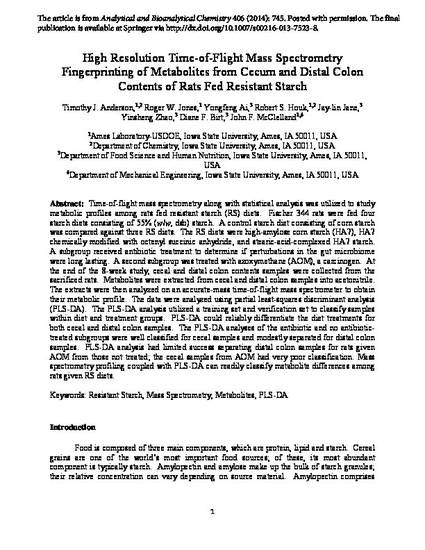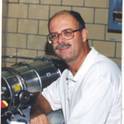
Time-of-flight mass spectrometry along with statistical analysis was utilized to study metabolic profiles among rats fed resistant starch (RS) diets. Fischer 344 rats were fed four starch diets consisting of 55 % (w/w, dbs) starch. A control starch diet consisting of corn starch was compared against three RS diets. The RS diets were high-amylose corn starch (HA7), HA7 chemically modified with octenyl succinic anhydride, and stearic-acid-complexed HA7 starch. A subgroup received antibiotic treatment to determine if perturbations in the gut microbiome were long lasting. A second subgroup was treated with azoxymethane (AOM), a carcinogen. At the end of the 8-week study, cecal and distal colon content samples were collected from the sacrificed rats. Metabolites were extracted from cecal and distal colon samples into acetonitrile. The extracts were then analyzed on an accurate-mass time-of-flight mass spectrometer to obtain their metabolic profile. The data were analyzed using partial least-squares discriminant analysis (PLS-DA). The PLS-DA analysis utilized a training set and verification set to classify samples within diet and treatment groups. PLS-DA could reliably differentiate the diet treatments for both cecal and distal colon samples. The PLS-DA analyses of the antibiotic and no antibiotic-treated subgroups were well classified for cecal samples and modestly separated for distal colon samples. PLS-DA analysis had limited success separating distal colon samples for rats given AOM from those not treated; the cecal samples from AOM had very poor classification. Mass spectrometry profiling coupled with PLS-DA can readily classify metabolite differences among rats given RS diets.
Available at: http://works.bepress.com/robert_houk/3/

This is a manuscript of an article in Analytical and Bioanalytical Chemistry 406 (2014): 745. Posted with permission. The final publication is available at Springer via http://dx.doi.org/10.1007/s00216-013-7523-8.